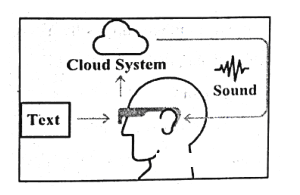��Ŀ����
����Ŀ���ٶ�Ӣ�������ʦҪ��ͬ��֮�佻�������ģ���������ͬ��д���������ġ�
���й���10�����Դ���ÿ���������������ÿ��������漰һ�����ʵ����ӡ�ɾ�����ġ�
���ӣ���ȱ�ʴ���һ��©�ַ��ţ�![]() ��������������д���üӵĴʡ�
��������������д���üӵĴʡ�
ɾ�����Ѷ���Ĵ���б�ߣ�![]() ��������
��������
�ģ��ڴ��Ĵ��»�һ���ߣ����ڸô�����д���ĺ�Ĵʡ�
ע�⣺1.ÿ���������ľ�����һ�ʣ�
2.ֻ������10�������ߣ��ӵ�11���𣩲��Ʒ֡�
Patience is of great importance in our daily life. Once I waited a bus to come at a stop. 30 minutes past, but no bus came. Both upset and annoyed, I decided to walk on feet. But no sooner had I left when the bus arrived. I thought if I had waited for one more minute, I would have caught it. If I chose to take a next bus, I would have to wait for other 30 minutes. Only then do I realize my problem. Being impatient will possible waste all the effort that we have put it in. Now whenever I am close to lose my patience, I��ll think of this experience.
���𰸡�1.waited �� a ֮���for
2. past ��passed
3. feet ��foot
4.when ��than
5. a ��the
6.other ��another
7. do ��did
8.possible ��possibly
9.ȥ��it
10.lose ��losing
��������
���Ȿ�����ڼ����ģ������ߵ��������¸����������ĵ���Ҫ�ԡ�
��1��waited���for ����̶����䡣����wait for�ȴ����Ⱥ����е�wait�Dz����ﶯ�ʣ�����Ҫ�ӽ�ʣ�Ȼ���ټӱ��
��2��past��Ϊpassed ����ν�ﶯ�ʡ����е�past���Ƕ��ʣ����ǽ�ʣ�����Dz�����Ӣ������ν��ġ�Ӧ��ʹ������һ��ͬ���Ķ���pass�Ĺ�ȥʽpassed��
��3��feet��Ϊfoot �����ʶ������on foot���У�����footӦ��ʹ�õ�����ʽ�����⣺�Ҿ�������ǰ����
��4��when��Ϊthan ����̶���ʽ����ʽno sooner ...than...һ...��....����һ�߿����������͵��ˡ�whenӦ�ú�hardly���ã��γ�hardly...when....�Ľṹ��ͬ����Ϊ��һ...��....����
��5��a��Ϊthe ����ڴʡ�����������busǰ����next���Σ�˵����ʾ��ָ��Ӧ��ʹ�ö��ڴ�the��
��6��other��Ϊanother ����̶��÷������ݴ�another��������֮ǰ����ʾ����...��....�������⣺�����ѡ��ȴ���һ��������ҵ��ٵ�30���ӡ�
��7��do��Ϊdid ����ʱ̬�����Ľ������ǹ�ȥ�����������飬����ͨƪ��ʹ��һ���ȥʱ������Ҫ��do��Ϊdid��
��8��possible��Ϊpossibly ���鸱�ʡ���Ӣ����ͨ��ʹ�ø�����״���������ݴʡ����ʻʣ����ݴ�ͨ���ھ�����������߱�����Ա�����ʹ�ø���possibly���ζ���waste all the effort��
��9��ɾ��it ������нṹ��������һ������Ӿ䣬��ϵ����thatָ�����д�all the effort��Ϊ����put�ı�����Դ���it�Ƕ���ģ�Ҫɾ������
��10��lose��Ϊlosing ���鶯���ʡ��̶�����be close to�ӽ�...������....�����е�to�ǽ�ʣ�����Ҫ�����ʻ��߶����������ı�����Ա���ֻ��losing��Ϊto�ı��
���ĸĴ��г��˴ʷ��Ĵ���֮�⣬���ǻ�Ҫע��䷨����ƪ�IJ��ԣ�
��һ���䷨�IJ��ԣ�
1��ν�������ϵ�һ�£�
I hope everything are ok with you. are ��Ϊis
2�����ԴӾ䣻
A man came up to him and asked that he needed. that�����ʣ��ڴӾ������κ����壬������ı���Ӿ�ȱ�����what��������Ӿ�������Ӿ�ı��
3����Ӿ䣻
This would save the life of many animals, some of then have almost died out. them��Ϊ which
��9��ɾ��it ������нṹ��������һ������Ӿ䣬��ϵ����thatָ�����д�all the effort��Ϊ����put�ı�����Դ���it�Ƕ���ģ�Ҫɾ������
4ǿ�����ͣ�It is/was +��ǿ���IJ���+that/who�� It was in 1949 when he joined the army. when��Ϊthat 5���ӽṹ�������ԡ������ԡ��Ե��Լ����ԡ�
(��)��ƪ�IJ��� ��ƪ�IJ�������
1�������е�ʱ̬�Ƿ�һ�£�
��7��do��Ϊdid ����ʱ̬�����Ľ������ǹ�ȥ�����������飬����ͨƪ��ʹ��һ���ȥʱ������Ҫ��do��Ϊdid��
2�������еĴ����Ƿ�һ�£�
3�������е����Ƿ�һ�£�
4�������еĴʡ����顢�Ӿ������Ƿ���ȷ��

